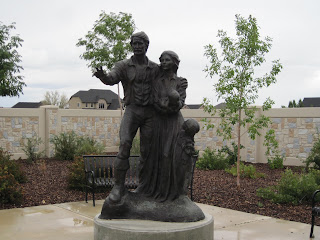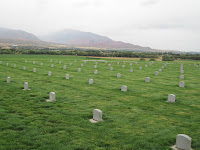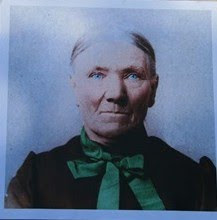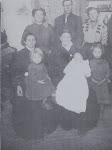Click on Images to Enlarge
Today there is an actual address, paved road and parking space, curb, gutter, sidewalks, green grass, lovely flowers and rock wall fencing. There is no doubt, when you drive up to this spot, there is something special here.
 |
| John Boice |
 |
| Mary Ann Barzee |
Over a period of a few years, I asked people I came in contact with in Spanish Fork, if they knew of the existence of a pioneer cemetery. I knew I was looking for a place high, overlooking the valley, and the Spanish Fork River. When Bill and I were looking at homes built on the new golf course, I asked a man the familiar question. To my surprise, and delight, he told me of a small cemetery located in a field. He drew a map and gave some instruction to help navigate the agricultural fields of corn, and alfalfa. With map in hand, Bill and I started out. The instructions went something like, drive about 3 miles, then take the second lane lined with corn fields and old wood posts with barbed wire, you'll see a tin sign on one of the posts... if you come to a farm house, you've gone to far....

As I looked around, visually I knew this place met the criteria Grandmother Asay laid out. More importantly, I knew in my heart this was the place.
As the years past, need for housing as populations grew, began to show itself in the changing landscape surrounding this little plot of land. As the land changed from agricultural use to housing subdivisions, corresponding changes were seen at the little cemetery. When I drove to visit the cemetery I was greeted by a new southern entrance instead of west. A tiny parking space was chisled from the side of the hill, and there rather steep stairs led to the cemetery at the top of the hill. A new square wooden sign greeted me when I reached the top that said, "Pioneer Historical Cemetery".
 |
| Pioneer Historical Cemetery |

The monument had received a "face lift" of sorts too. It was no longer facing West, and the tall vertical monument that is "typical" of pioneer monuments had spouted wings, and concrete steps. The gravel, weeds and small sandstone monuments were still there, and the iron sign had a fresh coat of paint. The farm house is framed under the sign.

The next time I visited around 2008, the changes I saw caused me some alarm. The headstones were missing and more changes were obviously in progress. This concerned me enough to make a visit to the Spanish Fork City offices. With the subdivision encroaching on the area, I wanted to make sure this cemetery was protected and it's integrity maintained.
 |
| Flags marking grave sites. |
The City had started a high-tech process to locate the various graves using echo type equipment to map out the cemetery. The headstones had been removed and I was told they were being "restored" and would be replaced. I was satisfied with what I had been told was happening and watched with interest as the project progressed.
That brings us to what you will find when you visit the little cemetery in Spanish Fork today. The Pioneer Heritage Cemetery was re-dedicated July 22, 2009. The monument has been removed, but the DUP marker set in the monument in 1943 has been re-set at the entrance gate of the newly renovated cemetery.
 |
| set in original monument |
 |
| names of known pioneers buried here |
 |
| Sculptors Erasmo and Alex Fuents |
The statue was unveiled by the sculptors and assisted by Mayor Joe Thomas at the re-dedication. The figure depicts a young pioneer family. "The statue embodies all those who lost loved ones and buried them here; but looked forward with hope and peace to the future."
 |
| sidewalk around perimeter with benches for reflection |
 |
| new concrete markers |
One cannot deny the renovation to the Heritage Cemetery has resulted in a peaceful setting, and in keeping with the high rent housing that surrounds it. But what happened to the red sandstone markers? I called and they ceased their "restoration" efforts as it "wasn't turning out well".
Brock Larson learned of the cemetery restoration and decided to make placing headstones at the new Pioneer Heritage Cemetery his Eagle Scout Project. "I thought that this would be cool because it was something to do for our ancestors." It is lovely, but I will always remember the first time I saw this almost forgotten cemetery, and the feeling it gave me as I looked at those hand chisled, red sandstone markers, knowing that one may have been placed by John and Mary Ann for their beloved Alpharetta. Still, now Alpharetta's name and legacy is known to all who come to this little cemetery and pause to read this bronzed plaque that tells her story. Grandmother Asay would be very pleased.
to read Alpharetta's story:
http://pioneerstories-asay.blogspot.com/2012/03/story-of-alpharetta-boice-indian-baby.html
to read Alpharetta's story:
http://pioneerstories-asay.blogspot.com/2012/03/story-of-alpharetta-boice-indian-baby.html
 |
| 1530 East 1884 South Spanish Fork |

























This is very clean and neatly arranged cemetry. Thanks for sharing all this background and historical information of its significance. It is really informative.
ReplyDeleteI found this as I was looking for photos of the old cemetery. I love your description of looking for the old cemetery. As kids we used to ride our bikes on those back roads and the cemetery was one of our landmarks. I was amazed to see the way that area looks now,
ReplyDelete